- Home
- Ann M. Martin
Claudia's Book
Claudia's Book Read online
CONTENTS
TITLE PAGE
CHAPTER 1
AN ARTIST’S LIFE BY CLAUDIA KISHI: BABY DAYS
CHAPTER 2
HAPPY BIRTHDAY TO ME
CHAPTER 3
CHAPTER 4
CHAPTER 5
THE TRUTH ABOUT THE TOOTH FAIRY
CHAPTER 6
CHAPTER 7
CHAPTER 8
BOO FOR FOURTH GRADE
CHAPTER 9
CHAPTER 10
CHAPTER 11
THE SEA ROSE
CHAPTER 12
CHAPTER 13
CHAPTER 14
CHAPTER 15
ACKNOWLEDGMENT
ABOUT THE AUTHOR
ALSO AVAILABLE
COPYRIGHT
I looked down at the blank sheet of paper on my desk. I leaned back and looked up at the ceiling. I turned and looked out the window.
Mistake. Through my windows I could see trees and clouds and the roofs of houses. In the distance, a v-shaped flock of geese flew by. Even further above that I caught the glint of light off a plane.
All of which reminded me that I’d rather be anywhere than right there at my desk getting ready to do my math homework. And then there was more homework after that, including a BIG writing project….
But as usual, I’m jumping into the middle of things. I guess that’s because I see things not as having a beginning and an end, but as a big picture spreading out all around me with me (of course) at the center.
Me? I’m Claudia. Claudia Kishi. I’m thirteen years old. I live in Stoneybrook with my parents and my older sister Janine. Janine is a genius. A real genius. I’m not kidding. Even though she’s only in high school, she’s already taking college courses because the high school stuff is too easy for her. Janine’s idea of an exciting afternoon is probably doing advanced college calculus.
Not me. I’m in eighth grade at Stoneybrook Middle School and I’m not a great student, like Janine. It’s not simply that I don’t like doing homework (who does—except Janine?), it’s that I’m not very good at spelling and writing and math. I’m smart, but, well, school and I (except for art and maybe phys ed) just don’t agree.
My poor parents don’t get it. My father is a lawyer and my mother is a librarian and they love books and writing and words, and they don’t always understand the way I see the world. But they’re getting used to the idea of having an artist for a daughter.
Because that’s what I am good at: art. Maybe that explains why I see things as a whole picture all at once, an image. Sometimes, when you’re an artist, you see just a fuzzy, vague sort of image at first and it becomes more clear as you work. Other times, you know exactly what you want to create and then the hard part is making your art match what you see in your head.
Math and English and spelling don’t exactly work that way.
I looked back down at my desk. What I saw was a piece of notebook paper with a stack of parallel blue lines. I could imagine all kinds of possibilities for that piece of paper, possibilities involving color and shape and angles and shadows.
What I couldn’t imagine was my math homework.
That’s when I decided to call Stacey McGill. Who is Stacey? She’s my best friend, fellow officer in the Baby-sitters Club (more about that a little later), and resident SMS math whiz.
Her line was busy. I sighed and hung up the phone. I stared longingly at my art supplies, but gave myself a good mental shake. If I started an art project, I might not even remember to call Stacey back and then I’d never start my homework.
I also said no to the Nancy Drew books hidden around my room (behind the “recommended” books my mother and father approve of). But I said yes to a snack.
Because I also have, well, an appreciation for what some people call junk food. But then, some people call wonderful works of art junk, too, right? Even Nancy Drew books! It’s all in how you look at it.
I got up and fished around in the pocket of my good winter coat (I only wear it on special occasions, so the pockets are a great place in which to “store” things). Sure enough, I’d stored a Fruit Roll-Up in one pocket and a tiny packet of Hershey’s Hugs in the other.
I returned to my desk, sat down, and opened the Fruit Roll-Up. Of course, that wasn’t the only junk food hidden around my room. I keep a large supply handy because I am the vice-president of the BSC and the meetings are held in my room. I’m the only member with my own phone line, so we can use the phone without having to worry about tying up the line so other people can’t use it. So I furnish the room, the phone, and the junk food.
Besides Stacey, five fellow officers and good friends of mine are in the BSC.
Kristy Thomas is the president of the club, because she’s the one who started it (one of her many great ideas). If there were an Olympic event in organization, Kristy would be winner and world champion. She’s also very responsible and has no problem making herself heard, which is a good thing since she lives in a very large family with two older brothers, one younger brother, one adopted sister, one stepsister, one stepbrother, a mother, a stepfather, a grandmother, a dog, a cranky cat, two goldfish, and (some of the younger kids in the family believe) a resident ghost. In addition to all that, Kristy is the captain of a kids’ softball team called Kristy’s Krushers.
The secretary of the BSC (and Kristy’s best friend) is Mary Anne Spier. Like Kristy, Mary Anne is short (although Kristy is the shortest kid in our class) and lives in an extended family. (Her mother died when Mary Anne was just a baby, and she and her father were a two-person family for a long time.) Mary Anne is also very organized. One of her jobs as the BSC secretary is to keep up to date the club record book with all our appointments in it, and she’s never, ever made a mistake. But while Kristy is outspoken, Mary Anne is shy and very sensitive. Don’t make the mistake of thinking that Mary Anne is a pushover because she is shy, though. Mary Anne can be just as stubborn as Kristy — maybe even more so.
Mary Anne’s extended family includes another member of the BSC: Dawn Schafer. Dawn moved to Stoneybrook, where her mother had grown up, with her mom and brother after her parents were divorced. After Mary Anne and Dawn became friends and discovered the fascinating parental fact that their parents had dated in high school, they naturally decided that Mr. Spier and Mrs. Schafer had to get together again. The result: a wedding. And now Mary Anne and her father live in this cool old farmhouse (that might be haunted) with Dawn and her mother, making Dawn Mary Anne’s best friend (along with Kristy) and her sister. Dawn is the alternate officer of the BSC. That means she takes over the duties of any BSC officer who can’t make a meeting. I think of Dawn whenever I eat junk food, because Dawn never lets the stuff touch her lips. She thinks sugar is disgusting. I still haven’t made up my mind about the tofu she eats. I actually like Tofutti, which is a sort of ice cream made of tofu. And Dawn, who is tall and has long, pale blonde hair and piercing blue eyes, is a good argument for healthy food — if being smart and laid-back and looking totally together is the result of all those sprouts and tofu!
Jessi Ramsey is one of our two junior officers. (The junior officers are in sixth grade, and can’t baby-sit at night yet, except for their own families.) Like Dawn, Jessi is tall and slender. She has black hair and warm brown eyes. But if you look at Jessi carefully, you can tell by the way she stands (and by the way she often wears her hair pulled back in a bun) that she is studying to be a ballet dancer. She gets up every morning at five-thirty to practice, and she takes lessons several times a week. Pretty awesome.
Mallory Pike, the other junior officer, couldn’t be more different in some ways than her best friend Jessi. Mal has red hair and freckles and wears glasses and braces. And it’s not that she is uncoordinated, but she’s not particular
ly athletic either. Being the oldest of eight kids (three of her brothers are triplets) makes her an excellent baby-sitter. It’s also given her a headstart on what she wants to do someday: write and illustrate children’s books. Meanwhile, she enjoys the relative calm of Jessi’s family (which is made up of two parents, one aunt, and Jessi’s younger sister and brother) and Jessi enjoys the high energy of the Pikes. Differences aside, Jessi and Mal have a lot in common. They share a love of mysteries, for example. And they both love horses.
Of course, I saved the best for last — my best friend and the BSC treasurer, Stacey.
I had never had a best friend before Stacey moved to Stoneybrook from New York. And when Stacey’s parents moved back to New York after Stacey and I had become best friends, it was awful. So while I wasn’t glad when Stacey’s parents later got divorced, I was totally pleased when Stacey and her mom returned to Stoneybrook.
Stacey is a math whiz and, like Dawn (but not me), she watches what she eats. Stacey has to. She has diabetes, a disease that makes it hard for her body to handle sugar. She has to be very careful about what she eats (she can’t have sugar) and even has to give herself insulin injections every day. If she isn’t careful, she could get very sick. Stacey takes it all in stride. When we hang out together, she munches on apples and pretzels while I go on Mallomar binges.
Stacey and I are about the same height and we have long hair, but hers is blonde. She is also a super cool, New York-style dresser, and probably the most sophisticated girl in SMS. She sometimes wears a lot of black (it’s a New York City thing) and always looks as if she knows exactly where she’s going and how to get there.
And besides being smart and elegant and a true blue loyal best friend, she’s excellent at explaining math things.
Math … sigh.
I reached for the phone again. This time Stacey answered.
“Hi,” I said. “Math.” (I didn’t have to tell her who it was.)
“Hold on,” she replied. A moment later, she was going over the questions with me. By the time we were through, she’d helped me figure out how to solve the problems. But we didn’t hang up immediately. Instead, even though we’d seen each other at school that day, we planned a shopping trip to the mall over the weekend.
And we talked about our latest assignment for school: to write our autobiographies. Stacey was thrilled with the project. I wasn’t — although I admitted to Stacey that I had been looking through my baby book and going through boxes of old stuff that my mom and dad had saved from when Janine and I were kids.
“I’m remembering the weirdest things,” I said. “Like the time I drew all over the bathroom walls and then tried to convince my mom it was an art show.”
Stacey cracked up. “Hey, you were doing something that was very in. Remember that art gallery owner in New York who had one of her first shows in her bathroom?”
I’d forgotten about that. I grinned. “Yeah … anyway, my parents and my sister are remembering these little-kid embarrassing things which I am not going to put in writing anywhere.”
“Tell me about it,” said Stacey. “But wait till you start writing, Claud. You’re going to get into it.”
“Maybe,” I said.
“It’s a self-portrait with words,” Stacey pointed out.
I thought about that for a moment. I liked the idea. I told Stacey so. Then we talked a little while longer about important things, such as what we were going to wear the next day.
I hung up and finished my homework (including my math).
Then I looked at myself in the mirror. A self-portrait with words. When I was in kindergarten and the teacher told us to draw a self-portrait, I’d drawn a butterfly. I was the only kid who had not drawn a literal portrait of herself: two eyes, a nose, a mouth.
My self-portrait had been different then (I still have it, and I still like it). Looking back at me from the mirror wasn’t a butterfly: just Claudia Kishi, with long black hair and brown eyes and an enormous shirt and patchwork vest over striped leggings. I looked down at my high-tops and back at the earrings I was wearing. I’d made them myself out of leftover bits of broken jewelry that my friends and family had given me: patchwork earrings.
I was still wearing butterfly colors. Maybe the kindergarten Claud was even smarter than she’d realized.
I went back to my desk, sat down, and pulled my notebook toward me.
I don’t remember being born, of course, but my mother and father do because they were both there (of course, my mother had to be there). My father said I started “expressing myself creatively the moment I was born.” My mother says it’s true: I started yelling when the doctor held me up and told my parents, “You have a beautiful baby girl.”
I don’t remember coming home from the hospital and I don’t remember my first meeting with the person in our family I looked most like when I was born (and look most like now), my grandmother, Mimi. Mimi had stayed home to take care of my older sister Janine, who was three and a half at the time.
I wish Mimi were still alive, so I could ask her about that meeting. There are a million things I wish I could ask her. I miss her every day. She always understood me and she was the person I was closest to in our family. She called me “my Claudia.” I have a picture of Mimi when she was twelve and a picture of me when I was twelve. I matted them and framed them together and they are hanging over my desk while I am writing this. I miss her, my Mimi.
I asked my sister if she remembered the first time she met me. And although my sister was only three and a half, she remembered.
I knocked on the door of Janine’s room. I knew she was inside, probably corresponding with Mars on her computer. I could hear her tapping away. It took her a long time to stop tapping and say, “Come in.” I guess she was pretty focused on what she was doing.
I went in. “May I sit down?” I asked.
Janine looked a little surprised to see me, but she nodded and I plopped down in her chair. I’d brought my notebook with me and I flipped it open. “I’d like to ask you a few questions,” I said.
Janine looked even more surprised. She took her hands off the keyboard and folded them in her lap. She straightened her shoulders and stared at me seriously. I wondered if this was how she takes tests or sits in interviews. (My sister has won a million awards for being a genius and has been written up in the newspaper a gazillion times since her own birth announcement.)
“To what do these questions pertain?” she asked.
She talks like that, too. But I’m used to it. I knew she meant: what was I going to ask her about?
“No sweat,” I assured her. “We have to write our autobiographies for school and I wondered if you remembered when I came home from the hospital.”
Janine relaxed — a little. And she smiled — sort of. She tilted her head and thought for a long moment. Then she said, “Yes.”
“Could you tell me what you remember?”
“Yes,” said Janine again. “It was in the early afternoon. Mimi and I had just finished lunch. We were having my favorite lunch at the time: alphabet soup and I had found all of the alphabet except y and z.”
Good grief, I thought.
“Mimi was trying to teach me how to spell ‘Claudia’ with the alphabet letters when we heard mom and dad pull into the driveway. A minute later, they came in through the side door, holding you.”
“You remember all that?” I exclaimed, taking notes as fast as I could.
Janine nodded. “Of course. You were in a green blanket. Mom handed you to Mimi and Mimi looked at you and said, ‘My Claudia.’ ”
I felt sudden tears sting my eyes. I bent over and pretended to erase something in my notebook. Janine paused for a moment, too, and cleared her throat.
Then she went on. “It was a sunny day. I remember that because we went outside and Dad took a picture of Mom, Mimi, me, and you together. Then I went back inside with Mimi and she told me I would have to be a good example for my new sister. So I ate all the letters in the alp
habet letters and then I finished my soup.”
Janine unfolded her hands and turned back to her computer.
“That’s it?” I asked.
“Yes,” said Janine, her fingers poised above her keyboard. “To the best of my recollection.”
“Thanks,” I said.
* * *
Mimi was my first best friend, really, before Stacey. But my first two friends were Kristy and Mary Anne, who lived next door to each other across the street from me. I don’t remember the first time we all met. I know our parents used to take turns taking care of the three of us even when we were pretty little.
But one of my earliest memories involves Kristy and Mary Anne. We were about four and a half or five and my folks had just had our driveway changed from gravel to cement. And they were having a little cement walkway made in the backyard.
We were fascinated by everything: the cement trucks, the tools, the way the guys putting the cement down kept smoothing it back and forth. We’d been playing with trucks and making cement mixer sounds in the sandbox in a corner of the yard.
Anyway, that day, they’d finished the walkway and had put up strings with strips of white cloth tied to them so nobody would walk on the wet walk by accident.
And of course, the moment we heard that you could leave permanent footprints in the cement, we were even more fascinated. We knew we wouldn’t be allowed to do this, so we didn’t ask about it.
Instead, we sat under a tree in the backyard, playing in the sandbox (Kristy had a toy dump truck that actually made beep, beep, beep sounds when it was dumping its cargo, of which I was deeply envious), while Mimi worked in the garden nearby. After awhile, Mimi pushed her straw hat back, wiped her-forehead, and asked us if we wanted something to drink.
We said no. We nodded when Mimi said she would be right back and agreed that we would stay where we were. Then we kept playing while Mimi checked the back gate to make sure it was locked so we couldn’t get out.
And the moment the back door closed we practically flew across the yard to the wet cement.
“Look!” I said, leaning over. I drew my fingers through the cement. I still remember how it felt: wet and gritty. I wondered if it would taste sandy and crunchy (maybe I liked junk food even then!). I wiggled my fingers and made four wavy lines in the cement.

 Karen's Tea Party
Karen's Tea Party Kristy and the Snobs
Kristy and the Snobs Best Kept Secret
Best Kept Secret Karen's Kittens
Karen's Kittens Karen's Big Job
Karen's Big Job Claudia and the Genius of Elm Street
Claudia and the Genius of Elm Street The Fire at Mary Anne's House
The Fire at Mary Anne's House Science Fair
Science Fair Me and Katie (The Pest)
Me and Katie (The Pest) Karen's Plane Trip
Karen's Plane Trip Jessi's Wish
Jessi's Wish Dawn and Too Many Sitters
Dawn and Too Many Sitters Jessi and the Jewel Thieves
Jessi and the Jewel Thieves Eleven Kids, One Summer
Eleven Kids, One Summer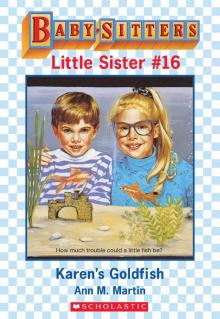 Karen's Goldfish
Karen's Goldfish Snow War
Snow War Abby and the Secret Society
Abby and the Secret Society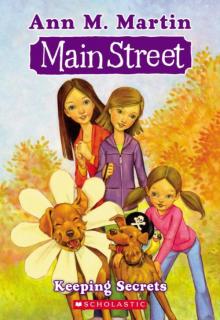 Keeping Secrets
Keeping Secrets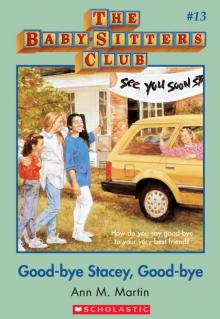 Good-Bye Stacey, Good-Bye
Good-Bye Stacey, Good-Bye Karen's Sleepover
Karen's Sleepover Claudia and the World's Cutest Baby
Claudia and the World's Cutest Baby Mary Anne Saves the Day
Mary Anne Saves the Day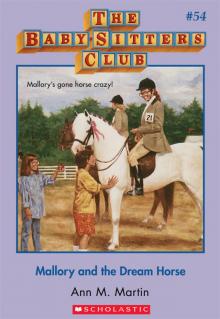 Mallory and the Dream Horse
Mallory and the Dream Horse Kristy and the Mystery Train
Kristy and the Mystery Train Dawn's Family Feud
Dawn's Family Feud Karen's Twin
Karen's Twin Little Miss Stoneybrook... And Dawn
Little Miss Stoneybrook... And Dawn Karen's Mistake
Karen's Mistake Karen's Movie Star
Karen's Movie Star Mallory and the Mystery Diary
Mallory and the Mystery Diary Karen's Monsters
Karen's Monsters Kristy + Bart = ?
Kristy + Bart = ? Karen's Dinosaur
Karen's Dinosaur Here Today
Here Today Karen's Carnival
Karen's Carnival How to Look for a Lost Dog
How to Look for a Lost Dog Stacey vs. Claudia
Stacey vs. Claudia Stacey's Ex-Boyfriend
Stacey's Ex-Boyfriend Here Come the Bridesmaids!
Here Come the Bridesmaids!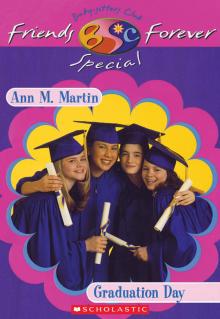 Graduation Day
Graduation Day Kristy's Big News
Kristy's Big News Karen's School Surprise
Karen's School Surprise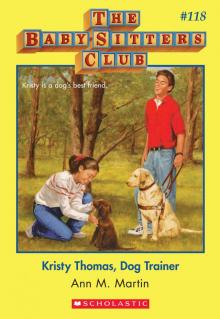 Kristy Thomas, Dog Trainer
Kristy Thomas, Dog Trainer Baby-Sitters' Christmas Chiller
Baby-Sitters' Christmas Chiller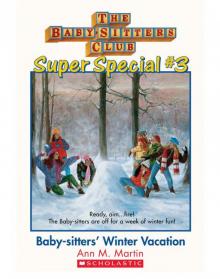 Baby-Sitters' Winter Vacation
Baby-Sitters' Winter Vacation Ten Good and Bad Things About My Life
Ten Good and Bad Things About My Life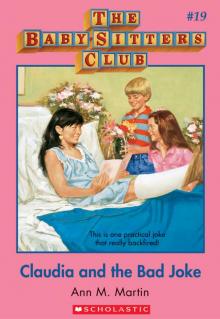 Claudia and the Bad Joke
Claudia and the Bad Joke Mary Anne's Makeover
Mary Anne's Makeover Stacey and the Fashion Victim
Stacey and the Fashion Victim Dawn Schafer, Undercover Baby-Sitter
Dawn Schafer, Undercover Baby-Sitter Karen's Tuba
Karen's Tuba Dawn's Wicked Stepsister
Dawn's Wicked Stepsister Diary Three: Dawn, Sunny, Maggie, Amalia, and Ducky
Diary Three: Dawn, Sunny, Maggie, Amalia, and Ducky Karen's Nanny
Karen's Nanny Jessi and the Awful Secret
Jessi and the Awful Secret Karen's New Year
Karen's New Year Karen's Candy
Karen's Candy Karen's President
Karen's President Mary Anne and the Great Romance
Mary Anne and the Great Romance Mary Anne + 2 Many Babies
Mary Anne + 2 Many Babies Kristy and the Copycat
Kristy and the Copycat Jessi and the Bad Baby-Sitter
Jessi and the Bad Baby-Sitter Claudia, Queen of the Seventh Grade
Claudia, Queen of the Seventh Grade Claudia and the Lighthouse Ghost
Claudia and the Lighthouse Ghost Karen's New Puppy
Karen's New Puppy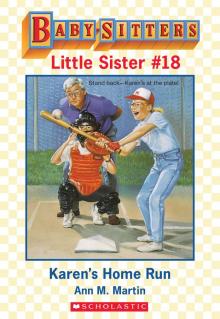 Karen's Home Run
Karen's Home Run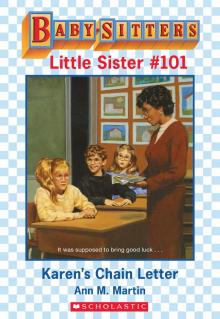 Karen's Chain Letter
Karen's Chain Letter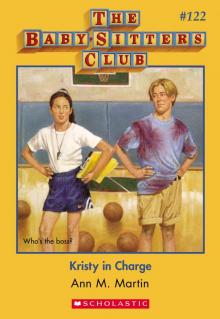 Kristy in Charge
Kristy in Charge Karen's Angel
Karen's Angel Mary Anne and Too Many Boys
Mary Anne and Too Many Boys Karen's Big Fight
Karen's Big Fight Karen's Spy Mystery
Karen's Spy Mystery Stacey's Big Crush
Stacey's Big Crush Karen's School
Karen's School Claudia and the Terrible Truth
Claudia and the Terrible Truth Karen's Cowboy
Karen's Cowboy The Summer Before
The Summer Before Beware, Dawn!
Beware, Dawn! Belle Teale
Belle Teale Claudia's Big Party
Claudia's Big Party The Secret Life of Mary Anne Spier
The Secret Life of Mary Anne Spier Karen's Book
Karen's Book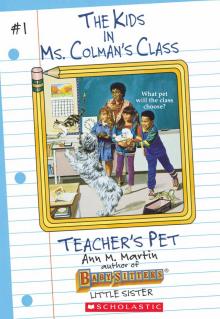 Teacher's Pet
Teacher's Pet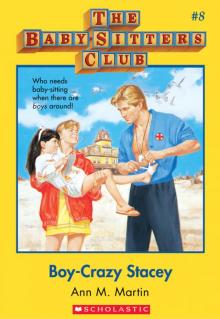 Boy-Crazy Stacey
Boy-Crazy Stacey Claudia and the Disaster Date
Claudia and the Disaster Date Author Day
Author Day Claudia and the Sad Good-Bye
Claudia and the Sad Good-Bye Kristy and the Worst Kid Ever
Kristy and the Worst Kid Ever Yours Turly, Shirley
Yours Turly, Shirley Class Play
Class Play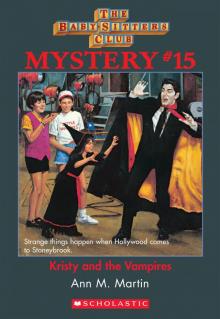 Kristy and the Vampires
Kristy and the Vampires Kristy and the Cat Burglar
Kristy and the Cat Burglar Karen's Pumpkin Patch
Karen's Pumpkin Patch Stacey and the Mystery at the Empty House
Stacey and the Mystery at the Empty House Karen's Chicken Pox
Karen's Chicken Pox Mary Anne and the Playground Fight
Mary Anne and the Playground Fight Stacey's Mistake
Stacey's Mistake Coming Apart
Coming Apart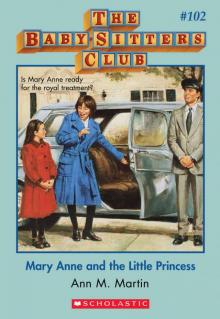 Mary Anne and the Little Princess
Mary Anne and the Little Princess Karen, Hannie and Nancy: The Three Musketeers
Karen, Hannie and Nancy: The Three Musketeers 'Tis the Season
'Tis the Season Claudia and Mean Janine
Claudia and Mean Janine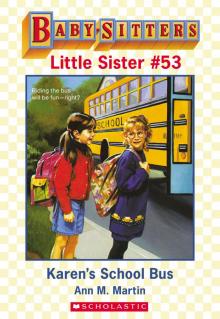 Karen's School Bus
Karen's School Bus Mary Anne's Big Breakup
Mary Anne's Big Breakup Rain Reign
Rain Reign Claudia and the Mystery at the Museum
Claudia and the Mystery at the Museum Claudia and the Great Search
Claudia and the Great Search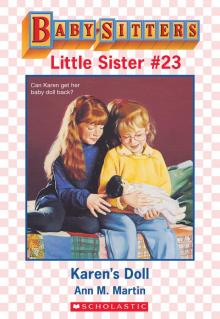 Karen's Doll
Karen's Doll Shannon's Story
Shannon's Story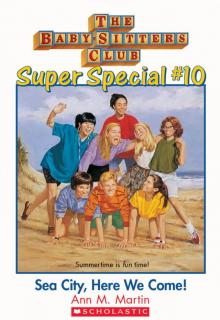 Sea City, Here We Come!
Sea City, Here We Come! Stacey and the Mystery of Stoneybrook
Stacey and the Mystery of Stoneybrook Karen's Treasure
Karen's Treasure Ten Rules for Living With My Sister
Ten Rules for Living With My Sister With You and Without You
With You and Without You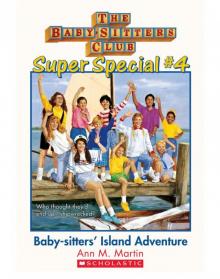 Baby-Sitters' Island Adventure
Baby-Sitters' Island Adventure Karen's Fishing Trip
Karen's Fishing Trip Dawn and the Big Sleepover
Dawn and the Big Sleepover New York, New York!
New York, New York! Ten Kids, No Pets
Ten Kids, No Pets Happy Holidays, Jessi
Happy Holidays, Jessi Halloween Parade
Halloween Parade Karen's New Holiday
Karen's New Holiday Kristy Power!
Kristy Power! Karen's Wish
Karen's Wish Claudia and the Mystery in the Painting
Claudia and the Mystery in the Painting Karen's Stepmother
Karen's Stepmother Abby in Wonderland
Abby in Wonderland Karen's Snow Day
Karen's Snow Day Kristy and the Secret of Susan
Kristy and the Secret of Susan Karen's Pony Camp
Karen's Pony Camp Karen's School Trip
Karen's School Trip Mary Anne to the Rescue
Mary Anne to the Rescue Karen's Unicorn
Karen's Unicorn Abby and the Notorious Neighbor
Abby and the Notorious Neighbor Stacey and the Haunted Masquerade
Stacey and the Haunted Masquerade Claudia Gets Her Guy
Claudia Gets Her Guy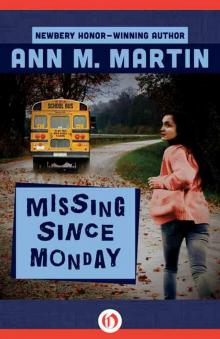 Missing Since Monday
Missing Since Monday Stacey's Choice
Stacey's Choice Stacey's Ex-Best Friend
Stacey's Ex-Best Friend Karen's New Teacher
Karen's New Teacher Karen's Accident
Karen's Accident Karen's Lucky Penny
Karen's Lucky Penny Karen's Cartwheel
Karen's Cartwheel Karen's Puppet Show
Karen's Puppet Show Spelling Bee
Spelling Bee Stacey's Problem
Stacey's Problem Stacey and the Stolen Hearts
Stacey and the Stolen Hearts Karen's Surprise
Karen's Surprise Karen's Worst Day
Karen's Worst Day The Ghost at Dawn's House
The Ghost at Dawn's House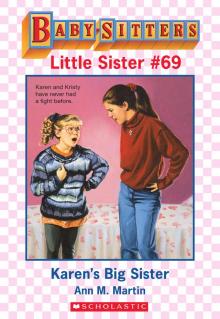 Karen's Big Sister
Karen's Big Sister Karen's Easter Parade
Karen's Easter Parade Mary Anne and the Silent Witness
Mary Anne and the Silent Witness Karen's Swim Meet
Karen's Swim Meet Mary Anne's Revenge
Mary Anne's Revenge Karen's Mystery
Karen's Mystery Stacey and the Mystery Money
Stacey and the Mystery Money Dawn and the Disappearing Dogs
Dawn and the Disappearing Dogs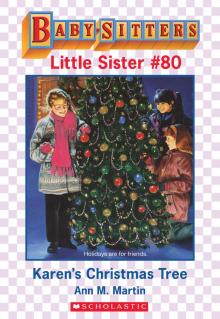 Karen's Christmas Tree
Karen's Christmas Tree Welcome to Camden Falls
Welcome to Camden Falls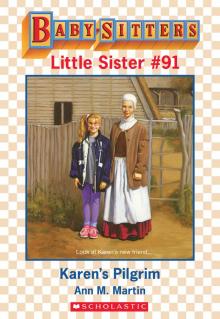 Karen's Pilgrim
Karen's Pilgrim Dawn and the Halloween Mystery
Dawn and the Halloween Mystery Mary Anne in the Middle
Mary Anne in the Middle Karen's Toys
Karen's Toys Kristy's Great Idea
Kristy's Great Idea Claudia and the Middle School Mystery
Claudia and the Middle School Mystery Karen's Big Weekend
Karen's Big Weekend Logan's Story
Logan's Story Karen's Yo-Yo
Karen's Yo-Yo Kristy's Book
Kristy's Book Mallory and the Ghost Cat
Mallory and the Ghost Cat Mary Anne and the Music
Mary Anne and the Music Karen's Tattletale
Karen's Tattletale Karen's County Fair
Karen's County Fair Karen's Mermaid
Karen's Mermaid Snowbound
Snowbound Karen's Movie
Karen's Movie Jessi and the Troublemaker
Jessi and the Troublemaker Baby-Sitters at Shadow Lake
Baby-Sitters at Shadow Lake Mallory on Strike
Mallory on Strike Jessi's Baby-Sitter
Jessi's Baby-Sitter Karen's Leprechaun
Karen's Leprechaun Claudia and the Phantom Phone Calls
Claudia and the Phantom Phone Calls Karen's Good-Bye
Karen's Good-Bye Karen's Figure Eight
Karen's Figure Eight Logan Likes Mary Anne!
Logan Likes Mary Anne! Mary Anne and the Zoo Mystery
Mary Anne and the Zoo Mystery Missy Piggle-Wiggle and the Whatever Cure
Missy Piggle-Wiggle and the Whatever Cure Dawn on the Coast
Dawn on the Coast Stacey and the Cheerleaders
Stacey and the Cheerleaders Claudia and the Clue in the Photograph
Claudia and the Clue in the Photograph Karen's New Friend
Karen's New Friend Mallory and the Trouble With Twins
Mallory and the Trouble With Twins Karen's Roller Skates
Karen's Roller Skates Abby and the Best Kid Ever
Abby and the Best Kid Ever Poor Mallory!
Poor Mallory! Karen's Witch
Karen's Witch Karen's Grandmothers
Karen's Grandmothers Slam Book
Slam Book Karen's School Picture
Karen's School Picture Karen's Reindeer
Karen's Reindeer Kristy's Big Day
Kristy's Big Day The Long Way Home
The Long Way Home Karen's Sleigh Ride
Karen's Sleigh Ride On Christmas Eve
On Christmas Eve Karen's Copycat
Karen's Copycat Karen's Ice Skates
Karen's Ice Skates Claudia and the Little Liar
Claudia and the Little Liar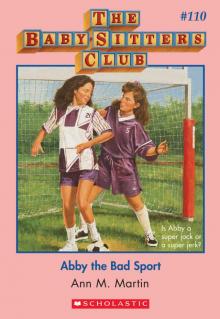 Abby the Bad Sport
Abby the Bad Sport The Baby-Sitters Club #5: Dawn and the Impossible Three
The Baby-Sitters Club #5: Dawn and the Impossible Three Abby's Book
Abby's Book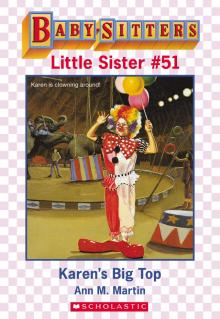 Karen's Big Top
Karen's Big Top Main Street #8: Special Delivery
Main Street #8: Special Delivery Kristy and the Kidnapper
Kristy and the Kidnapper Karen's Ski Trip
Karen's Ski Trip Karen's Hurricane
Karen's Hurricane Stacey and the Mystery at the Mall
Stacey and the Mystery at the Mall Jessi and the Superbrat
Jessi and the Superbrat Kristy and the Baby Parade
Kristy and the Baby Parade Karen's New Bike
Karen's New Bike Karen's Big City Mystery
Karen's Big City Mystery Baby-Sitters' European Vacation
Baby-Sitters' European Vacation Hello, Mallory
Hello, Mallory Dawn's Big Date
Dawn's Big Date Karen's Christmas Carol
Karen's Christmas Carol Jessi's Horrible Prank
Jessi's Horrible Prank Kristy and the Missing Fortune
Kristy and the Missing Fortune Kristy and the Haunted Mansion
Kristy and the Haunted Mansion Jessi's Big Break
Jessi's Big Break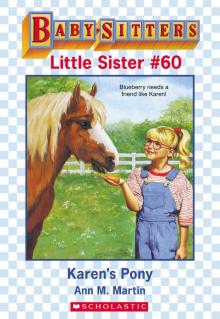 Karen's Pony
Karen's Pony Welcome Home, Mary Anne
Welcome Home, Mary Anne Stacey the Math Whiz
Stacey the Math Whiz September Surprises
September Surprises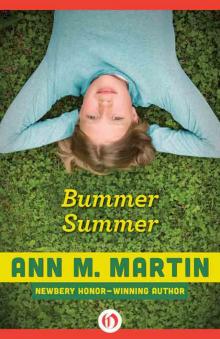 Bummer Summer
Bummer Summer Karen's Secret
Karen's Secret Abby's Twin
Abby's Twin Main Street #4: Best Friends
Main Street #4: Best Friends Karen's Big Move
Karen's Big Move Mary Anne Misses Logan
Mary Anne Misses Logan Stacey's Book
Stacey's Book Claudia and the Perfect Boy
Claudia and the Perfect Boy Holiday Time
Holiday Time Stacey's Broken Heart
Stacey's Broken Heart Karen's Field Day
Karen's Field Day Kristy's Worst Idea
Kristy's Worst Idea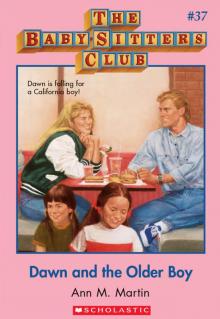 Dawn and the Older Boy
Dawn and the Older Boy Karen's Brothers
Karen's Brothers Claudia's Friend
Claudia's Friend Mary Anne and the Haunted Bookstore
Mary Anne and the Haunted Bookstore Dawn and Whitney, Friends Forever
Dawn and Whitney, Friends Forever Summer School
Summer School Karen's Birthday
Karen's Birthday Karen's Black Cat
Karen's Black Cat Stacey McGill... Matchmaker?
Stacey McGill... Matchmaker? Claudia's Book
Claudia's Book Main Street #2: Needle and Thread
Main Street #2: Needle and Thread Karen's Runaway Turkey
Karen's Runaway Turkey Karen's Campout
Karen's Campout Karen's Bunny
Karen's Bunny Claudia and the New Girl
Claudia and the New Girl Karen's Wedding
Karen's Wedding Karen's Promise
Karen's Promise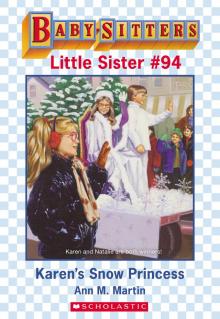 Karen's Snow Princess
Karen's Snow Princess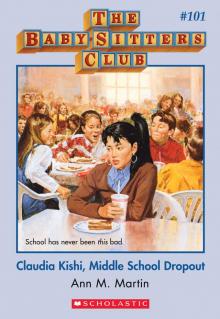 Claudia Kishi, Middle School Dropout
Claudia Kishi, Middle School Dropout Starring the Baby-Sitters Club!
Starring the Baby-Sitters Club! Kristy for President
Kristy for President California Girls!
California Girls! Maid Mary Anne
Maid Mary Anne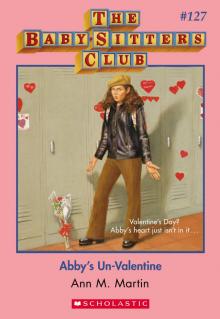 Abby's Un-Valentine
Abby's Un-Valentine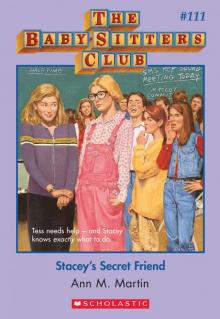 Stacey's Secret Friend
Stacey's Secret Friend Karen's Haunted House
Karen's Haunted House Claudia and Crazy Peaches
Claudia and Crazy Peaches Karen's Prize
Karen's Prize Get Well Soon, Mallory!
Get Well Soon, Mallory! Karen's Doll Hospital
Karen's Doll Hospital Karen's Newspaper
Karen's Newspaper Karen's Toothache
Karen's Toothache Mary Anne and Miss Priss
Mary Anne and Miss Priss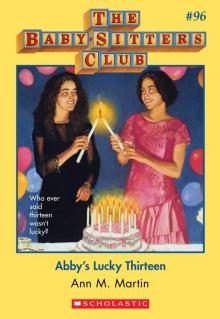 Abby's Lucky Thirteen
Abby's Lucky Thirteen The Secret Book Club
The Secret Book Club The All-New Mallory Pike
The All-New Mallory Pike Karen's Turkey Day
Karen's Turkey Day Karen's Magician
Karen's Magician Mary Anne and the Library Mystery
Mary Anne and the Library Mystery Diary One: Dawn, Sunny, Maggie, Amalia, and Ducky
Diary One: Dawn, Sunny, Maggie, Amalia, and Ducky Mary Anne and the Secret in the Attic
Mary Anne and the Secret in the Attic Kristy and the Mother's Day Surprise
Kristy and the Mother's Day Surprise Karen's in Love
Karen's in Love Welcome to the BSC, Abby
Welcome to the BSC, Abby Karen's Kittycat Club
Karen's Kittycat Club The Mystery at Claudia's House
The Mystery at Claudia's House The Truth About Stacey
The Truth About Stacey Karen's Bully
Karen's Bully Karen's Gift
Karen's Gift BSC in the USA
BSC in the USA Everything for a Dog
Everything for a Dog Dawn and the We Love Kids Club
Dawn and the We Love Kids Club Karen's Ghost
Karen's Ghost Stacey's Lie
Stacey's Lie Jessi's Secret Language
Jessi's Secret Language Kristy and the Missing Child
Kristy and the Missing Child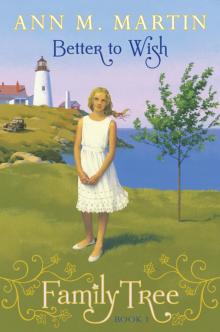 Better to Wish
Better to Wish Baby-Sitters on Board!
Baby-Sitters on Board! Kristy at Bat
Kristy at Bat Everything Changes
Everything Changes Don't Give Up, Mallory
Don't Give Up, Mallory A Dog's Life: The Autobiography of a Stray
A Dog's Life: The Autobiography of a Stray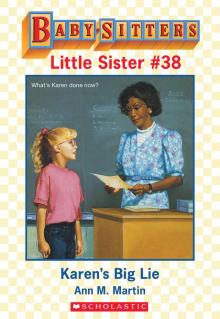 Karen's Big Lie
Karen's Big Lie Karen's Show and Share
Karen's Show and Share Mallory Hates Boys (and Gym)
Mallory Hates Boys (and Gym) Diary Two: Dawn, Sunny, Maggie, Amalia, and Ducky
Diary Two: Dawn, Sunny, Maggie, Amalia, and Ducky Karen's Pen Pal
Karen's Pen Pal Claudia and the Friendship Feud
Claudia and the Friendship Feud Karen's Secret Valentine
Karen's Secret Valentine Keep Out, Claudia!
Keep Out, Claudia!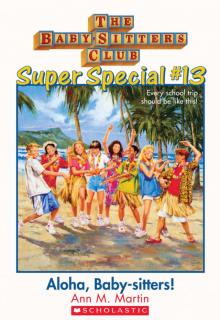 Aloha, Baby-Sitters!
Aloha, Baby-Sitters! Welcome Back, Stacey
Welcome Back, Stacey Jessi Ramsey, Pet-Sitter
Jessi Ramsey, Pet-Sitter Karen's Pizza Party
Karen's Pizza Party Kristy and the Dirty Diapers
Kristy and the Dirty Diapers Staying Together
Staying Together Dawn and the Surfer Ghost
Dawn and the Surfer Ghost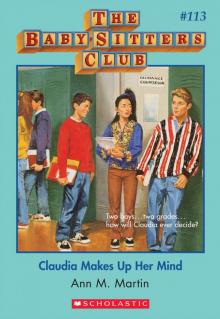 Claudia Makes Up Her Mind
Claudia Makes Up Her Mind Jessi's Gold Medal
Jessi's Gold Medal Karen's Kite
Karen's Kite Baby Animal Zoo
Baby Animal Zoo Dawn's Big Move
Dawn's Big Move Karen's Big Joke
Karen's Big Joke Karen's Lemonade Stand
Karen's Lemonade Stand Ma and Pa Dracula
Ma and Pa Dracula Baby-Sitters' Haunted House
Baby-Sitters' Haunted House Abby and the Mystery Baby
Abby and the Mystery Baby Home Is the Place
Home Is the Place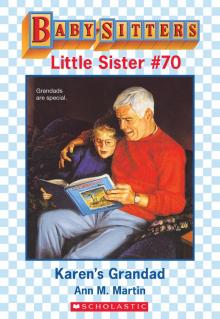 Karen's Grandad
Karen's Grandad Twin Trouble
Twin Trouble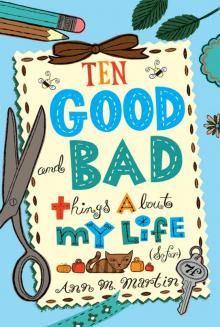 Ten Good and Bad Things About My Life (So Far)
Ten Good and Bad Things About My Life (So Far) Diary Two
Diary Two Baby-Sitters Club 027
Baby-Sitters Club 027 Claudia and the Mystery Painting
Claudia and the Mystery Painting Diary One
Diary One Baby-Sitters Club 037
Baby-Sitters Club 037 Baby-Sitters Club 028
Baby-Sitters Club 028 Baby-Sitters Club 085
Baby-Sitters Club 085 Dawn Schaffer Undercover Baby-Sitter
Dawn Schaffer Undercover Baby-Sitter Jessi's Babysitter
Jessi's Babysitter The Baby-Sitters Club #110: Abby the Bad Sport (Baby-Sitters Club, The)
The Baby-Sitters Club #110: Abby the Bad Sport (Baby-Sitters Club, The) Karen's Little Sister
Karen's Little Sister Baby-Sitters Club 058
Baby-Sitters Club 058 Claudia And The Genius On Elm St.
Claudia And The Genius On Elm St. Missy Piggle-Wiggle and the Sticky-Fingers Cure
Missy Piggle-Wiggle and the Sticky-Fingers Cure Kristy and Kidnapper
Kristy and Kidnapper Baby-Sitters Club 041
Baby-Sitters Club 041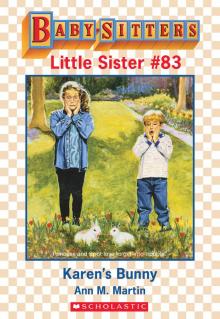 Karen's Bunny Trouble
Karen's Bunny Trouble Baby-Sitters Club 032
Baby-Sitters Club 032 Diary Three
Diary Three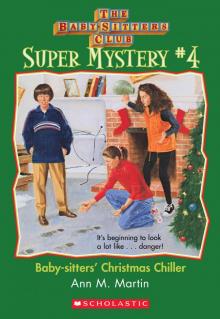 Christmas Chiller
Christmas Chiller Karen's Half-Birthday
Karen's Half-Birthday Needle and Thread
Needle and Thread Secret Life of Mary Anne Spier
Secret Life of Mary Anne Spier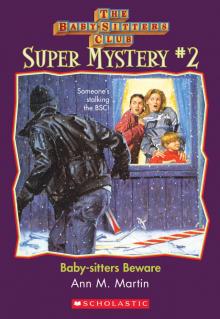 Baby-Sitters Beware
Baby-Sitters Beware Claudia Kishi, Middle School Drop-Out
Claudia Kishi, Middle School Drop-Out Logan Likes Mary Anne !
Logan Likes Mary Anne ! Baby-Sitters Club 061
Baby-Sitters Club 061 Best Friends
Best Friends Baby-Sitters Club 031
Baby-Sitters Club 031 Karen's Little Witch
Karen's Little Witch Jessi Ramsey, Petsitter
Jessi Ramsey, Petsitter Baby-Sitters Club 123
Baby-Sitters Club 123 Baby-Sitters Club 059
Baby-Sitters Club 059 Baby-Sitters Club 033
Baby-Sitters Club 033 Baby-Sitters Club 060
Baby-Sitters Club 060 Baby-Sitters Club 094
Baby-Sitters Club 094 The Baby-Sitters Club #99: Stacey's Broken Heart
The Baby-Sitters Club #99: Stacey's Broken Heart The Baby-Sitters Club #109: Mary Anne to the Rescue (Baby-Sitters Club, The)
The Baby-Sitters Club #109: Mary Anne to the Rescue (Baby-Sitters Club, The) Mystery At Claudia's House
Mystery At Claudia's House Claudia And The Sad Goodbye
Claudia And The Sad Goodbye Mary Anne's Big Break-Up
Mary Anne's Big Break-Up Baby-Sitters Club 025
Baby-Sitters Club 025 Baby-Sitters Club 042
Baby-Sitters Club 042 Stacey and the Mystery of the Empty House
Stacey and the Mystery of the Empty House Karen's Baby-Sitter
Karen's Baby-Sitter Claudia's Friendship Feud
Claudia's Friendship Feud Baby-Sitters Club 090
Baby-Sitters Club 090 Baby-Sitters Club 021
Baby-Sitters Club 021 Baby-Sitters Club 056
Baby-Sitters Club 056 Baby-Sitters Club 040
Baby-Sitters Club 040 The Baby-Sitters Club #108: Don't Give Up, Mallory (Baby-Sitters Club, The)
The Baby-Sitters Club #108: Don't Give Up, Mallory (Baby-Sitters Club, The) Dawn and the Impossible Three
Dawn and the Impossible Three The Snow War
The Snow War Special Delivery
Special Delivery Baby-Sitters Club 057
Baby-Sitters Club 057 Mary Anne And Too Many Babies
Mary Anne And Too Many Babies Baby-Sitters Club 030
Baby-Sitters Club 030